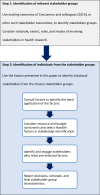Factors to Consider During Identification and Invitation of Individuals in a Multi-stakeholder Research Partnership
- PMID: 35132560
- PMCID: PMC9708980
- DOI: 10.1007/s11606-022-07411-w
Factors to Consider During Identification and Invitation of Individuals in a Multi-stakeholder Research Partnership
Abstract
Background: Health research teams increasingly partner with stakeholders to produce research that is relevant, accessible, and widely used. Previous work has covered stakeholder group identification.
Objective: We aimed to develop factors for health research teams to consider during identification and invitation of individual representatives in a multi-stakeholder research partnership, with the aim of forming equitable and informed teams.
Design: Consensus development.
Participants: We involved 16 stakeholders from the international Multi-Stakeholder Engagement (MuSE) Consortium, including patients and the public, providers, payers of health services/purchasers, policy makers, programme managers, peer review editors, and principal investigators.
Approach: We engaged stakeholders in factor development and as co-authors of this manuscript. Using a modified Delphi approach, we gathered stakeholder views concerning a preliminary list of 18 factors. Over two feedback rounds, using qualitative and quantitative analysis, we concentrated these into ten factors.
Key results: We present seven highly desirable factors: 'expertise or experience', 'ability and willingness to represent the stakeholder group', 'inclusivity (equity, diversity and intersectionality)', 'communication skills', 'commitment and time capacity', 'financial and non-financial relationships and activities, and conflict of interest', 'training support and funding needs'. Additionally, three factors are desirable: 'influence', 'research relevant values', 'previous stakeholder engagement'.
Conclusions: We present factors for research teams to consider during identification and invitation of individual representatives in a multi-stakeholder research partnership. Policy makers and guideline developers may benefit from considering the factors in stakeholder identification and invitation. Research funders may consider stipulating consideration of the factors in funding applications. We outline how these factors can be implemented and exemplify how their use has the potential to improve the quality and relevancy of health research.
Keywords: International health; Patient engagement; Patient-centred outcomes research; Research design; Stakeholder engagement.
© 2022. The Author(s).
Conflict of interest statement
None exist: AM, ABB, CEE, EL, ET, EA, IB, JP, LD, LT, LM, MA, MP, MS, NS, PT, RGS, RP, SC, TK, TA.
TC — recipient of grants or contracts from: Centers for Disease Control and Prevention/NIOSH; National Institutes of Health/NCATS;Patient-Centered Outcomes Research Institute; National Evaluation System for health Technology; Centers for Medicare and Medicaid Innovation. 100 shares of Moderna, Inc.
VW — a co-principal investigator on the CIHR grant (PJT-155970) which is funding the Multi-Stakeholder Engagement (MuSE) Consortium
ET, RP — worked for Cochrane for the majority of project duration.
Figures
References
-
- Heneghan C, Mahtani KR, Goldacre B, Godlee F, Macdonald H, Jarvies D. Evidence based medicine manifesto for better healthcare. British Medical Journal Publishing Group; 2017. - PubMed
-
- PCORI. The Value of Engagement [Internet]. The value of engagement. 2018 [cited 2021 Jun 28]. Available from: https://www.pcori.org/engagement/value-engagement


